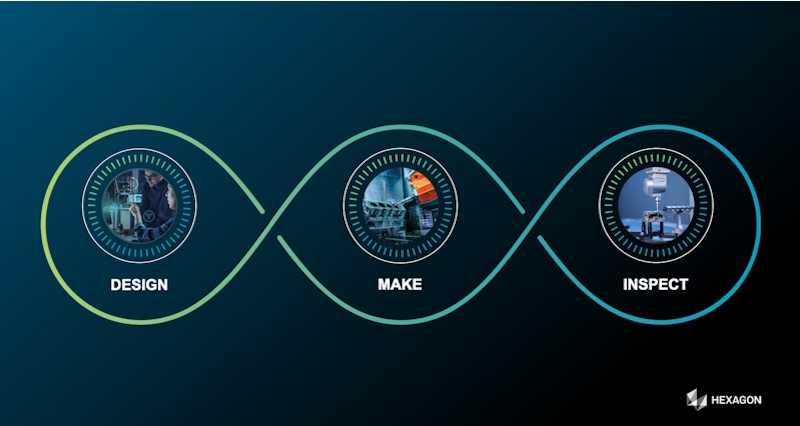Imagine having state-of-the-art equipment, but a lack of trained people to operate it. Imagine having excess product that was in demand but couldn’t reach the customer, blocked funds, tied-up capital or unused patent rights. It’s like driving with the brakes on. That’s what data silos are doing to your organisation.
In each of those situations you’d do your utmost to break down the barrier and put your resources to work. That’s the situation many of us are in today with data.
Data is the most important resource we have, yet 98% of manufacturers are not using it to the highest potential.
Whether your business priority is to improve efficiency, resolve production challenges or gear up for digital transformation – accurate and timely data is the lynchpin. Nowadays this is widely accepted in manufacturing.
The reality on the ground however, even among major OEMs, is often characterised by an ongoing struggle to put data to work. According to Hexagon’s Advanced Manufacturing report, just 2% report no data challenges.
Zoom in and it becomes easy to see why. Data management, data quality and data completeness are all common issues.
42% of our sample reported difficulty sharing insights between teams while 35% grapple with internal data silos. Quality challenges also dominate with 35% citing incomplete data, 31% outdated data and 30% inaccurate data as issues.
Compounding this is the inability to identify actionable insights. So regardless of data accessibility or quality, 35% simply cannot put their data to work – even if it exists in all the right places.
There is a long way to go for our sector, so in this post I will explore the role of data in successful manufacturing transformation, how to tackle silos and create the optimal data processes for your business.
What is a data silo?
Data is considered ‘siloed’ when it is not accessible due to the way it is stored. In the context of manufacturing, with its distinct departments and process stages, a data silo is an isolated information store that cannot be accessed by other individuals, teams or software programmes.
A data silo could be as large as an entire department, team, or as small as a piece of software or even an analog process. In the pre-digital past, all data was kept in silos, usually a filing cabinet in a locked office.
Now we find ourselves in an age where data-driven insights are key to gaining a competitive edge and breaking down data silos is critical. Organisations are increasingly adopting strategies, technologies, and processes that promote data sharing, collaboration, and integration across departments, turning siloed data into unified data systems.
Yet data silos still exist. We’re still not doing it right. We’ve moved on from analogue systems but many still have locally stored data. The filing cabinets of the past have gone but the mentality remains.
Most of the time, an individual, team or department will not know that they are creating a data silo. They may be working on their desktop rather than saving a document centrally, for example on SharePoint where colleagues can access it.
Silos keep data it in isolation, in the dark. Accessing these silos, meant talking to the right person, finding the key, even waiting for someone to come back to their desk.
In the past, there was no standardisation. If you moved from one company to another, you’d have to learn an entirely new system. These things even varied between departments of the same organisation. If you filed a piece of data in the wrong place, you might lose it forever. Imagine the damage a simple clerical error could do to your business.
Data and manufacturing success
Unlike anything else, data from across the manufacturing value chain promises to connect our thinking, our processes and approaches, allowing us to shape a circular, holistic process for continuous improvement.
Most factory assets are fixed: data is fluid and constantly changing. It needs to move to do its thing. In the manufacturing context data needs to flow freely across the value chain as a single digital thread enabling informed decisions at every stage.
The data we generate at the start of the process can be used to improve innovation, forecasting and resource allocation. Data from the design phase needs to be leveraged for successful production. In-production data can be applied to increase automation of processes, further optimising efficiency, reducing downtime and addressing quality issues and non-conformances sooner. At the end of the process, underutilised quality assurance data can be used to close the insight loop meaning designers can leverage the learnings for continuous improvement.
A significant barrier is the very structure of manufacturing organisations, which have evolved to be departmental. Teams contribute their bit, however, to truly accelerate manufacturing transformation, we need to collaborate, share our data with other teams up and downstream.
According to the EU – up to 80% of a product’s environmental impacts are determined at the design phase. By the same logic, performance, longevity, functionality and indeed manufacturability of products must also be heavily determined at the design stage.
We do need to look earlier in the process for improvements. By powering digital twins, data can accurately simulate the latest designs, forecast machinery maintenance, improve process parameters, facilitate root cause analysis and “design–out” problematic features or materials.
However, it’s more important to leverage data from across the value chain and put it to work in a circular way. This enables us to do much more than shift left. It enables us to optimise against every metric, transforming performance inside and outside of the factory from concept to customer.
Appealing to a digitally native workforce
Entering the workplace, new digitally native younger generations would laugh at the thought of a filing cabinet – let alone rummaging through one to find vital insight about the manufacturing process. They’d be right. It is laughable, trying to predict how and where a piece of data might be, discovering someone’s hidden stash of chocolate at the back of the bottom drawer.
Manufacturing companies need to attract talent with new digital skills. To do that, we must demonstrate our existing proficiency in these areas. Digital transformation is not a luxury or even an option, it’s an essential part of staying competitive. When organisations establish themselves as leading the change, they will naturally appeal to the best up-and-coming talented individuals.
On the other hand, the skills gap is generally a result of losing experienced personnel, before a company can replace them. In that way, entire data silos can disappear in the form of valuable tribal knowledge.
Harnessing tribal knowledge and passing it on to the newer generation of digitally inclined professionals is another way of eliminating data silos. Incorporating strategies for knowledge transfer and leveraging technology to facilitate this can significantly ease this transition and there are an increasing number of digital applications designed to create and facilitate that.
These tools take the endless mess of paperwork, closed files and disorganised knowledge, transforming it into something easily accessible, sharable and editable.
The biggest data silos in manufacturing
In manufacturing we tend to divide our activities into design, make, inspect. These three areas also represent the biggest data silos in manufacturing.
They have different leaders, different budgets and budget cycles, different physical locations. They might even have entirely different organisational cultures.
Departments might use proprietary software with file types that make data sharing difficult.
There might be security protocols that restrict data flow. Complexity and the need for specialist knowledge can lead to silos occurring especially where data needs interpreting. Modern software solutions solve these problems by creating a digital thread that links these functions together.
The latest technology creates a single storage space that transcends time and space because it exists everywhere at the same time. It is an infinite, smart filing cabinet searchable, and infinitely connected to any number of other systems.
How to eliminate data silos
Eliminating data silos first means knowing and acknowledging they exist. This is easy to say but difficult to achieve. Organisations must identify all the data and information they hold, where they hold it and who has access to it. Where data silos exist, employees may not even be aware of them.
With that awareness in place we can develop a unified data plan and set of policies to address the situation. Encourage cross-department collaboration and invest in the right integration tools.
Taking the right approach to data-driven transformation
Manufacturers in all verticals are under immense pressure to innovate or risk falling behind. Almost overnight, disruptive new approaches and technologies can change everything about the way we design, resource and manufacture.
If we have the ability to act on our data, it means we understand our process fully. We can quickly simulate new approaches while the agility provided by rich understanding and context means we are able to turn on the head of a pin – innovating new products and processes quickly.
The ultimate aim of every manufacturer is to make better products in better ways. If you have the data you can do this both iteratively and incrementally unlocking major innovation leaps.
Embarking on a data-driven transformation may seem overwhelming, but by breaking it down into manageable steps, manufacturers can leverage data to drive significant improvements.
A gradual, systematic approach will help you to accomplish your top priorities while giving you a broader, deeper set of data to build on. This is where AI comes in.
No single human has the time, skills or processing power to trawl huge, disparate datasets for insights and deliver something actionable – data transformation depends entirely on machine learning. Tools like AI are advancing so quickly that we need to be part of their adoption to fully benefit.
The insights unlocked by AI will empower your people, your teams and your entire business to achieve the incredible. Organise your data and then start work. Now is the time.
Take action: How to eliminate data silos and leverage data
The path to modernise and transition from traditional methods to a streamlined design, make, inspect setup, can appear daunting. How do manufacturers navigate through this journey?
Every manufacturer faces a different reality with their data. So how do we modernise from where we are today? How do we overcome legacy process and technology hurdles to develop an end-to-end design, make, inspect setup that is right for our own unique business?
How do we dismantle legacy processes and infuse technology to create an ecosystem that’s custom-fit for unique business needs? Central to this is accurate and timely data.
- Build your data-driven strategy from the ground up in each area of your business, from the back office through design, production and inspection, based on the insights you need to meet your business priorities.
- Once all the individual areas of your business are gathering data, harness open platforms to integrate data from disparate sources and share information throughout the product lifecycle.
- With a picture of complete, connected data, your business can use artificial intelligence (AI) and machine learning (ML) tools to make actionable recommendations. Use these to power transformation in all areas of your business.
- Start small with an aligned team of experts and work with them to deliver value before scaling up to priorities with similar data dependencies.
- Finally, build a culture where failure is OK. This will help demonstrate that management is committing to the new way of working and putting resources and momentum behind it.
And now we want to hear from you. What are the biggest data silos in your organisation? Do you agree with us? Did we get it right? Share this blog on your networks and let’s continue the conversation online.



















